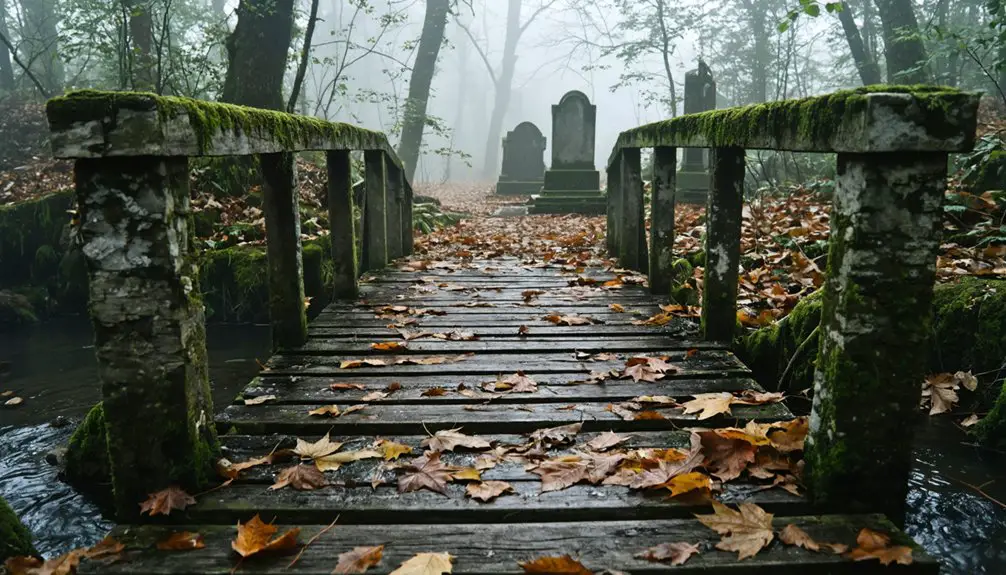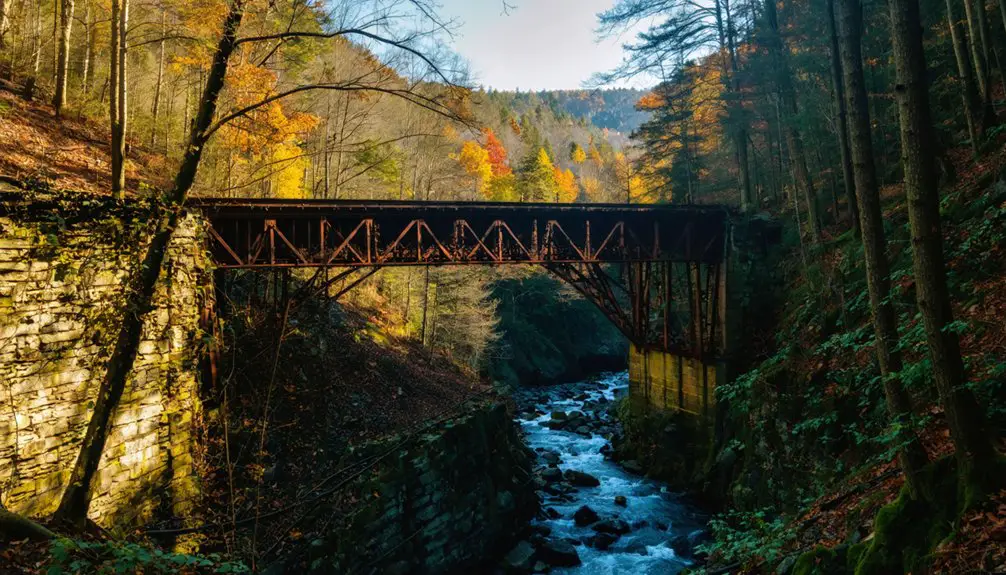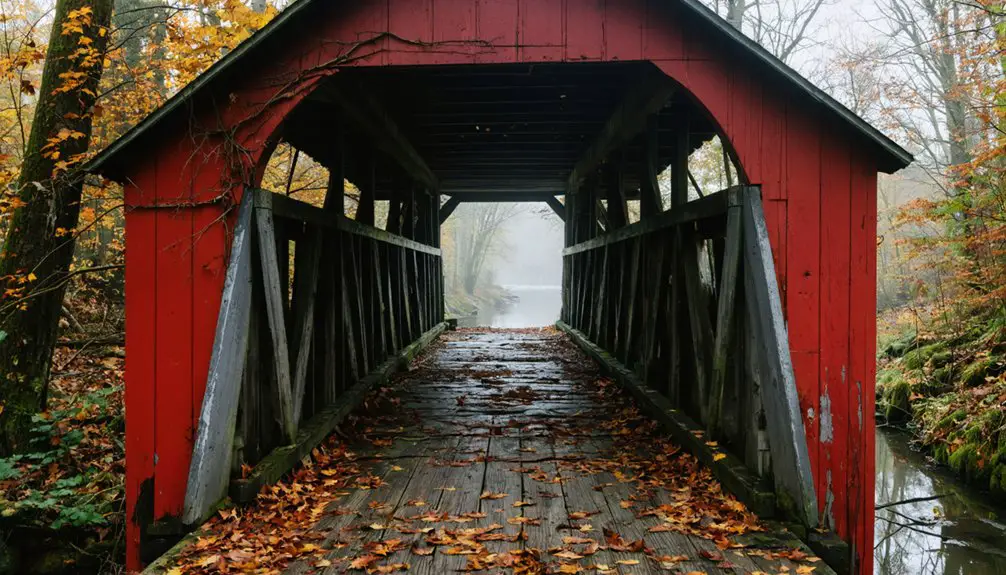You’ll find Quaker Bridge, a Victorian-era Pratt through truss bridge built in 1898, spanning the Little Shenango River in Mercer County, Pennsylvania. Originally part of William Penn’s colonial settlement vision, this historic site features nearly 500 unmarked Quaker graves, ruins of Tompson’s Tavern, and the iconic bridge that survived demolition attempts in 2006. Local legends of supernatural phenomena and rich colonial history make this ghost town’s abandoned structures and dense vegetation even more intriguing.
Key Takeaways
- Quaker Bridge, Pennsylvania became a ghost town following economic decline and decreased religious gatherings in the area.
- The site features the historic 1898 Pratt through truss bridge, original bridge abutments, and ruins of Tompson’s Tavern.
- Nearly 500 unmarked graves in the Quaker burial ground reflect the community’s historical presence and religious practices.
- Tourism now centers on the area’s Quaker heritage, supernatural legends, and architectural remains of the abandoned settlement.
- The settlement’s decline began after modern roads diminished the bridge’s importance as a vital crossing point.
Origins of the Colonial Settlement
When King Charles II granted William Penn over 45,000 square miles of land in 1681, he set in motion the founding of Pennsylvania, a colony that would become a haven for religious freedom.
You’ll find that Penn’s settlement strategies prioritized locations near navigable waterways and healthy, dry sites that could sustain growing communities. Penn envisioned creating a “greene Country Towne” with spacious lots between houses.
Under Penn’s colonial governance structure, you’d have seen a balanced system with a governor, Provincial Council, and elected General Assembly where property-owning freemen participated in decision-making.
Penn’s innovative three-part government empowered property owners to help shape colonial policy through direct participation in legislative affairs.
By 1682, the first wave of settlers – about 4,000 people on 50 ships – arrived to establish their new lives.
Despite harsh conditions and the need for temporary shelters like dugouts, these pioneering colonists laid the groundwork for what would become a thriving example of democratic self-governance. The colony experienced remarkable growth as the population expanded from 2,000 to 18,000 within a decade.
The Bridge That Started It All
The Cleveland Bridge & Engineering Company constructed the iconic Quaker Bridge in 1898, spanning 125 feet across the Little Shenango River in Mercer County, Pennsylvania.
This Victorian-era Pratt through truss bridge, with its distinctive pin-connected design, served as a crucial transportation link between Erie and Pittsburgh for over a century. The bridge earned recognition when it was listed on the National Register in 1988.
You’ll find this bridge’s greatest legacy in its role as a catalyst for historic bridge preservation. The bridge once carried traffic on Williamson Road before its closure.
When PennDOT scheduled it for demolition in 2006, local citizens and the Historic Quaker Bridge Foundation sprang into action. Their successful community activism saved what would become the fourth state-owned metal truss bridge preserved in Pennsylvania and the first in the western region.
Though now bypassed by a newer bridge, the Quaker Bridge stands as a monument to grassroots preservation efforts and 19th-century engineering innovation.
Quaker Heritage and Religious Life
Founded by religious dissenters in mid-1600s England, the Society of Friends established a distinctive presence in Pennsylvania that shaped the region’s cultural and social fabric.
Their Quaker practices centered on the belief in an “inner light” – a direct connection to God accessible to all people without clergy intermediaries.
The Quaker belief in direct divine connection empowered individuals to seek God’s truth without relying on religious authority figures.
You’ll find that spiritual equality defined their worship style, which took place in simple meetinghouses where anyone could speak if moved by divine inspiration.
They rejected formal ceremonies and social hierarchies, adopting plain speech and dress to express their commitment to equality.
In their communities, you’d see women taking active roles in worship and governance, while their peaceful approach influenced everything from local planning to Native American relations.
Under William Penn’s leadership, Pennsylvania became a holy experiment designed to demonstrate Quaker principles of religious tolerance and peaceful governance.
Their deep commitment to social justice led them to establish humane mental hospitals and advocate for prison reform in Pennsylvania.
Rise and Decline of the Community
Building upon their religious foundation, Quaker Bridge emerged as an essential crossing point in 1772 when early settlers constructed a cedar timber bridge over the Batsto River.
The community dynamics centered around Tompson’s Tavern, which served travelers and locals until its destruction by fire in the mid-1800s. The establishment of regular mail routes in 1797 brought increased traffic and commerce through the area. Much like the nearby stone chapel construction of 1895, the bridge represented a crucial development in local infrastructure.
You’ll find that economic shifts gradually transformed this once-vital crossing. While the bridge initially thrived as a significant link for Quaker meetings and local trade, it couldn’t sustain growth beyond its religious and transportation functions.
The arrival of modern roads diminished the crossing’s strategic importance, and the community failed to develop alternative industries. Without the tavern’s social hub and with declining religious gatherings, the population dwindled.
The lack of economic diversification ultimately sealed Quaker Bridge’s fate as activities shifted to more developed areas.
Local Legends and Folklore
Over generations, Quaker Bridge has accumulated a rich tapestry of supernatural legends and local folklore, particularly centered around its historic chapel and cemetery.
The most enduring stories revolve around alleged witch trials and executions from the 18th or 19th century, where 13 accused witches were supposedly tried and hanged near the Quaker meeting house. Their bodies, legend claims, lie beneath Johnson Drive’s bumpy surface. Much like the area’s famous Pine Barrens outlaws, these dark tales emerged during times of social and economic upheaval.
You’ll find tales of paranormal phenomena throughout the area, from spectral figures near Quaker Bridge to mysterious hellhounds guarding the cemetery at night. Similar to other ghost towns in America, vandals have damaged many of the remaining structures, further eroding the historical value of the site.
During the 1980s Satanic Panic, these stories intensified, with claims of cult activity and ritual sites. Drivers report ghostly witch apparitions following their vehicles, while visitors describe unexplained footsteps, moving objects, and eerie laughter around the chapel grounds.
Architectural Remnants Today
While paranormal tales surround Quaker Bridge, its physical remains tell their own compelling story.
Today, you’ll find a fascinating blend of historical architecture spanning different eras, from late 1800s stone abutments to more recent metal truss components, showcasing the site’s architectural significance over time.
- The original 1772 cedar timber construction has vanished, replaced by steel deck gratings and preserved ashlar stone abutments.
- A mysterious time capsule stone from the 1870s remains embedded in the west abutment.
- The surrounding forest has reclaimed most nearby structures, including Tompson’s Tavern’s foundations.
- Structural challenges persist due to the remote location and dense vegetation.
The bridge’s preservation status reflects Pennsylvania’s commitment to protecting historic metal truss bridges, though its isolated setting continues to complicate restoration efforts.
Cemetery Mysteries and Burial Practices

As you walk through this historic Quaker burial ground, you’ll notice the stark contrast between the few dozen marked graves and the nearly 500 total burials, reflecting the Quakers’ commitment to equality in death through unmarked plots.
The minimalist stone markers you’ll find date primarily from the late 18th to late 19th century, eschewing elaborate decoration in favor of simple inscriptions that honor the Quaker values of humility.
Your journey through time continues with scattered modern burials from the early 2000s, showing how this sacred space maintains its connection to present-day Quaker practices while preserving its historical significance.
Unmarked Graves Tell Stories
Simplicity and humility define the burial practices at Quaker Bridge’s cemetery, where unmarked graves far outnumber those with tombstones.
These silent histories reflect the Quaker values of modesty and equality, telling stories of a community that embraced religious tolerance and social justice.
Within these grounds, you’ll discover unmarked stories of:
- Former slaves who found freedom through Quaker abolitionists
- African American community members welcomed when other cemeteries refused
- Early settlers who chose simple burial practices over ornate monuments
- Freed persons whose legal emancipation led to their final rest here
While many graves lack physical markers, archival records and family histories help piece together the identities of those buried here, preserving their legacy in Quaker Bridge’s rich historical tapestry.
Quaker Burial Ground Traditions
Throughout Quaker Bridge’s burial grounds, centuries-old traditions reflect the Society of Friends’ core values through mindful practices that honor both the deceased and the earth.
You’ll find small pillowtop headstones rising just 6-10 inches above the ground, marking graves without ostentation or hierarchy. These simple markers embody the Quaker commitment to equality, even in death.
The community’s eco-friendly practices eschew embalming chemicals and metal caskets in favor of plain pine boxes that naturally decompose.
When you attend a Quaker burial, you’ll experience a Meeting for Worship rather than a formal ceremony. In shared silence, mourners may feel moved to speak, sharing memories or readings.
These grounds welcome all, historically providing rest for Indigenous people, African Americans, and strangers – a reflection of Quaker inclusivity that transcends social boundaries.
Stone Markers Over Time
When you visit Quaker Bridge’s burial grounds today, you’ll notice a striking evolution in grave markers that spans three centuries.
The historical significance of these grounds reveals the fascinating progression from unmarked graves to simple stone markers, reflecting changing attitudes within Quaker communities.
The timeline of grave marker evolution shows:
- Pre-1698: No markers permitted, creating vast spans of unmarked earth due to strict religious beliefs against pride.
- 1698-1850s: Rare exceptions like Joseph Sharp’s stone appear, though most graves remained unmarked.
- Mid-1800s: Introduction of plain stones with minimal information (name, death date, age).
- Late 1800s: Gradual relaxation of rules, allowing simple markers while maintaining modest designs.
This progression mirrors the community’s journey from rigid religious practices to more flexible traditions while preserving core Quaker values.
Preservation Efforts and Historical Status

You’ll find the Quaker Bridge’s preservation story centered on the dedicated efforts of the Mercer County Historical Society, which successfully advocated for protecting this rare 19th-century metal truss bridge during PennDOT’s renovation plans in the 2000s.
Through careful documentation and local advocacy, the bridge became Western Pennsylvania’s first preserved metal truss bridge, with special attention paid to salvaging original abutment stones and steel decking.
Despite lacking formal statewide historic designation, the bridge’s structural heritage remains protected through ongoing community involvement and historical recognition of its significance as one of Pennsylvania’s earliest metal truss bridges.
Structural Heritage Documentation
The preservation journey of Quaker Bridge stands as a demonstration to Pennsylvania’s commitment to protecting its historic infrastructure.
Through careful heritage mapping and structural analysis, you’ll discover a remarkable timeline of construction dating back to 1772, when settlers crafted the original crossing using local cedar timbers from the Batsto/Mullica riverbanks.
- The bridge’s stone abutments contain inscriptions from the 1870s, revealing evidence of an earlier wooden covered bridge.
- Original materials include steel deck grating and ashlar stone elements, prioritized for preservation.
- A mysterious time capsule stone in the west abutment awaits archaeological investigation.
- The structure holds distinction as one of Pennsylvania’s earliest state-owned historic metal truss bridges.
The site’s documentation encompasses both engineering heritage and Quaker settlement patterns, making it an essential piece of Western Pennsylvania’s historic landscape.
Conservation Through Local Advocacy
Since the early 2000s, dedicated local advocacy groups have spearheaded conservation efforts at Quaker Bridge through strategic partnerships and community initiatives.
The Mercer County Historical Society leads these advocacy strategies by collaborating with state agencies and mobilizing preservation-minded volunteers to monitor the site.
You’ll find various community initiatives working to protect this historic landmark, from educational outreach programs to fundraising events that support preservation.
Local historians document the bridge’s significance while advocacy campaigns urge PennDOT to implement preservation-friendly maintenance.
Despite challenges like limited physical remnants and dense foliage, these groups pursue grants and government funding to guarantee the site’s future.
They’re also working to secure formal protection status through historic registers while preserving oral histories and engineering heritage for future generations.
Ghost Town Classification and Tourism
Modern ghost town classifications encompass Quaker Bridge due to its abandoned structures, significant population decline, and historical remnants dating back to 1772.
The site’s ghost town tourism draws visitors interested in its cultural significance, particularly its Quaker heritage and mysterious past.
You’ll find these compelling features at Quaker Bridge:
- The original bridge abutments and metal truss design that served Quaker yearly meetings
- Ruins of Tompson’s Tavern, now hidden beneath overgrown foliage
- Historic cemeteries containing nearly 500 unmarked graves
- Preserved boundary stones potentially containing time capsules
The area’s appeal extends beyond historical interest, as urban legends and paranormal stories from the 1980s “Satanic Panic” continue to attract adventure seekers and ghost hunters to this remote location.
Frequently Asked Questions
What Are the Best Times to Visit for Paranormal Investigations?
You’ll find peak activity during late fall and early winter seasons, especially between midnight and 4 AM. Visit during overcast nights with minimal moonlight for ideal investigation conditions.
How Many Original Quaker Families Lived in the Settlement?
You won’t find exact records of original family numbers, though Quaker heritage and family lineage records suggest multiple households gathered regularly in the 1770s for yearly meetings and community activities.
Was Tompson’s Tavern Connected to the Underground Railroad?
You can’t definitively claim Thompson’s Tavern was connected to the Underground Railroad. While local Quakers supported abolition, there’s no documented evidence linking this specific tavern to Underground Railroad activities.
Are There Any Surviving Photographs of the Original Wooden Bridge?
You’ll find two rare photographs showing the historic documentation of the original covered wooden bridge’s architecture from 1847-1894, preserved by the Westchester County Historical Society, including a bird’s-eye view.
What Native American Tribes Inhabited the Area Before Quaker Settlement?
You’ll find the Lenape were the primary Native tribes in this region, alongside the Susquehannock, Shawnee, and Iroquois Confederacy. These groups held historical significance before Quaker settlement began.
References
- https://www.njpinebarrens.com/the-story-of-quaker-bridge/
- https://pabucketlist.com/exploring-the-haunted-quaker-church-in-fayette-county/
- https://stuofdoom.com/main/?p=193
- https://historicbridges.org/bridges/browser/?bridgebrowser=pennsylvania/quaker/
- https://en.wikipedia.org/wiki/List_of_ghost_towns_in_Pennsylvania
- https://www.britannica.com/place/Philadelphia/History
- https://philadelphiaencyclopedia.org/essays/pennsylvania-founding/
- https://en.wikipedia.org/wiki/History_of_Pennsylvania
- http://www.chichestermeetinghouse.org/resources/2016/8/14/quaker-settlers-in-the-delaware-valley
- https://collaborativehistory.gse.upenn.edu/stories/original-people-and-their-land-lenape-pre-history-18th-century



